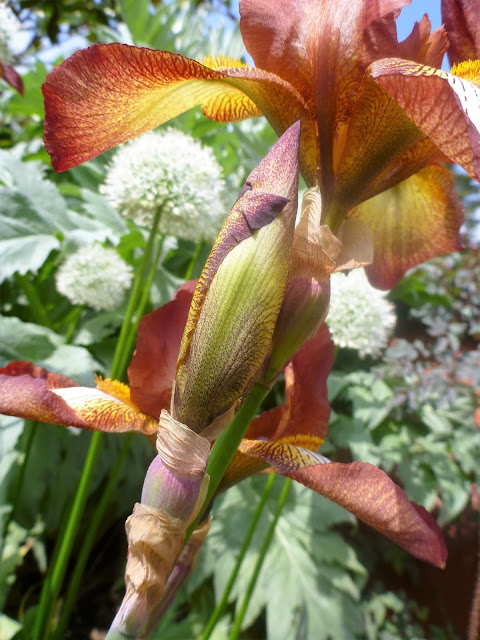 |
| Visitors to our recent NGS open garden commented that this border could have been seen in a Chelsea show garden |
Often Chelsea gardens put plants together that would not in real life flower at the same time, but you can still take inspiration from the colour combinations created. This year many of the gardens featured orange flowers, ranging from dusky orange, through peach to vibrant orange. We use orange flowers in many places in the garden either to compliment or contrast.
Geums were a popular plant at Chelsea and come in shades of red, orange and yellow. They are easy to grow plants that happily weave their flower heads around their neighbours. They have a fairly long flowering season and pretty foliage. Grow in sun or part shade towards the front of a border.
 |
| Geum Prinses Julianna against aquilegia foliage |
Three Chelsea show gardens included Iris Kent Pride: Vestra Wealth's Garden of Mindful Living, The Modern Slavery Garden and The Winton Beauty of Mathematics Garden. We have this iris planted with white alliums in our sunny front garden. Its unusual browny-orange colour works well with many other plants, as long as it isn't too crowded - the corms need to be baked by the sun.
 |
| Iris Kent Pride with Allium White Empress and the silver leaves of Cynara cardunculus in the background |
A combination of Lysicmachia atropurpurea Beaujolais and a pale peach geum is one that I will be copying. The pale peach will pick out the peachy tones on nearby Lupin Masterpiece.
 |
| Lupin Masterpiece with the blue-grey foliage and deep plum flowers of Lysimachia atropurpurea Beaujolais in the background |
 |
| A peach coloured geum that might have to be relocated next to Lysicmachia atropurpurea Beaujolais and Lupin Masterpiece |
The most inspiring garden for me was The Winton Beauty of Mathematics Garden, designed by Nick Bailey, which combined pines, succulents and frothy perennials. We have many of these plants in our garden already, but I now have new ideas about ways to combine them.
 |
| Aeoniums (tree houseleeks) are easy to grow in outdoor pots, but need protection from frost in the winter |
 |
| The yellow lupin flowers pick up the creamy variegation of the cornus leaves |
Also of interest in the garden at the moment -
 |
| Allium Christophii with ladybird poppies - a combination inspired by a visit to Great Dixter |
Removing faded Spring flowers and seed heads - seed heads of wild garlic and bluebells are removed before they set seed, and faded forget-me-nots are pulled up to make way for summer perennials.
Watering and feeding - we feed potted plants and daylilies and agapanthus in the borders every two weeks from now on to ensure the best flower and fruit.
Mowing the lawn - we do this weekly now. A neat law makes the exuberant borders stand out.

No comments:
Post a Comment